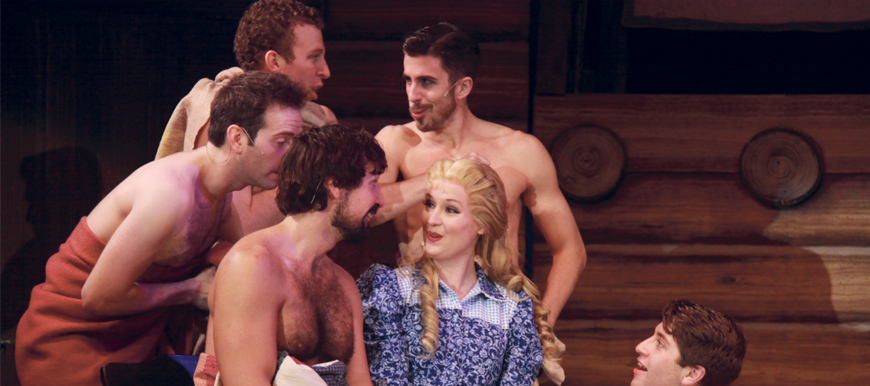“Seven Brides for Seven Brothers” parallels modern-day issues
Under blue lighting that added to the sharp, mountain imagery, Justun Hart stepped onto the Ellen Eccles Theater stage and debuted the play “Seven Brides for Seven Brothers.”
“I was excited because I’ve seen it before, and I heard good things about it,” said Hattie Huybergts, a freshman studying geography at Utah State University.
Presented by the Prather Entertainment Group, the Eccles theater was selected as one of the locations as part of the group’s tour.
The play only had two showings on Saturday, 2 p.m. and 7:30 p.m. Audience members lined up behind the red velvet ropes in the theater lobby well before seating for the play began.
“Our kids bought us tickets for my 80th birthday, so we’ve had our tickets since August,” said Annatte McMurdie, a Logan resident. “We love the music and comedy. The whole acting is really cute.”
Created as a musical film in 1954 and later adapted to a play, the material features Adam Pontipee, the oldest of seven brothers. Pontipee leaves his mountain home in search for a wife in the nearest town. Upon meeting Milly, an orphaned barmaid, Pontipee proposes and marries her the same day. However, Pontipee doesn’t mention to Milly that he lives with his six brothers.
As the play progresses, Milly tries to make the Pontipee brothers fit for marriage. When the brothers become discouraged after a mishap at a social in town, Pontipee comes up with his own plan to marry off his brothers, based on the Roman legend of the Sabine women.
Hart, who performs as the oldest Pontipee, said the play was created for an audience of a different era, but there was still enough flexibility to make it relatable to modern audiences.
“I think that I approach the character Adam much more as a man that is trying to learn,” Hart said. “He’s learning what it means to be a man and what is his role is, how to be a husband, how to be a father, which is much more interesting than just playing it as, ‘These men are going to take the women, and it will be fine in the end,’ which is a really stupid message and a flat message. So I think we’ve added depth with the aspect of learning.”
Though Kate Marshall’s character, Milly, was also created in a “Leave it to Beaver” era as Hart described it, Marshall said that the Milly’s emotions and situation in the beginning of the play can reach across decades.
“Milly has to figure out how to make it work or she’ll go back to square one,” Marsahall said, “because there is no other option even for her. And women find themselves in those desperate situations in this time too — different circumstances but equally as desperate.”
Marshall joked that while her husband had never lied to her about how many brothers he had, she related to Milly on a personal level.
Due to the amount of time touring, Marshall said she and her husband of four years had to find a way to make things work in her marriage. Marshall said she found herself relating to Milly and how she works to “make her marriage survive.”
Hart also related how he was able to connect to the struggles his character faced.
“As a man, I am constantly trying to figure women out,” Hart said. “It’s a lot of trying to put aside my stubborn, my own thought process and, ‘Why can’t this be simple?’ and it’s a lot of, ‘I’m trying to understand you.'”
He continued, saying that trying to understand someone else’s way of thinking has helped him relate to his character.
“And I think trying to put somebody else’s needs before your own or trying to put a woman’s interest ahead of your own is something that I relate to a lot,” Hart said. “I’m constantly trying to find the tools that I need to be a better man so when I meet a woman I can be that much better of husband and eventually father.”
— katherine.l.larsen@gmail.com

